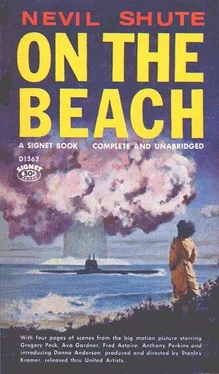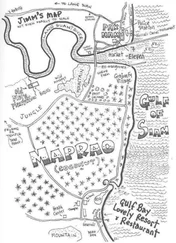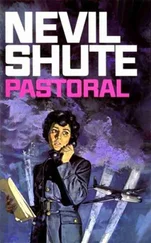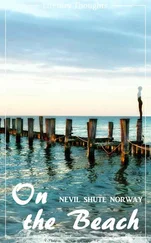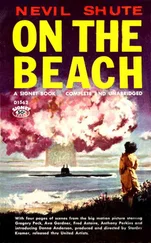Next day he drove to Williamstown, in at the dockyard gates, and parked the Morris on the quayside by the practically deserted aircraft carrier. In the evening he drove home again.
His duties at the dockyard were now merely nominal. Work upon the submarine was going very slowly, and his presence was required upon the job no more than two days in each week, which fitted in well with the requirements of his little car. Dwight Towers was there most days in the morning, but he, too, had become mobile. The First Naval Member had sent for him one morning and, with poker face, had declared that it was only fitting that the Supreme Commander of the U.S. Naval Forces should have transport at his disposal, and Dwight had found himself presented with a grey painted Chevrolet with Leading Seaman Edgar as the driver. He used it principally for going to the club for lunch or driving out to Harkaway to walk beside the bullock as they spread the dung, while the leading seaman shovelled silage.
The last part of July was a very pleasant time for most people. The weather was seasonably bad with high winds and plenty of rain and a temperature down in the low forties, but men and women cast off the restraints that long had galled them. The weekly wage packet became of little value or importance; if you went into the works on Friday you would probably get it whether you had worked or not, and when you had it there was little you could do with it. In the butcher’s shop the cash desk would accept money thrust at them but didn’t grieve much if it wasn’t, and if the meat was there you took it. If it wasn’t, you just went and looked for somewhere where there was some. There was all day to do it in.
On the high mountains the skiers skied weekdays and weekends alike. In their little garden, Mary and Peter Holmes laid out the new beds and built a fence around the vegetable garden, planting a passion fruit vine to climb all over it. They had never had so much time for gardening before, or made such progress. "It’s going to be beautiful," she said contentedly. "It’s going to be the prettiest garden of its size in Falmouth."
In the city mews John Osborne worked on the Ferrari with a small team of enthusiasts to help him. The Australian Grand Prix at that time was the premier motor race of the Southern Hemisphere, and it had been decided to advance the date of the race that year from November to August the 17th. On previous occasions the race had been held at Melbourne in the Albert Park, roughly corresponding to Central Park in New York or Hyde Park in London. The organizing club would have liked to race for the last time in Albert Park but the difficulties proved to be insuperable. It was clear from the outset that there would be a shortage of marshals and a shortage of labour to provide the most elementary safety precautions for the crowd of a hundred and fifty thousand people who might well be expected to attend. Nobody worried very much about the prospect of a car spinning off the course and killing a few spectators, or the prospect of permission to use the park for racing in future years being withheld. It seemed unlikely, however, that there would be sufficient marshals ever to get the crowds off the road and away from the path of the oncoming cars, and, unusual though the times might be, few of the drivers were prepared to drive straight into a crowd of onlookers at a hundred and twenty miles an hour. Racing motorcars are frail at those speeds, and a collision even with one person would put the car out of the race. It was decided regretfully that it was impracticable to run the Australian Grand Prix in Albert Park, and that the race would have to take place at the track at Tooradin.
The race in this way became a race for racing drivers only; in the prevailing difficulties of transport not very many spectators could be expected to drive forty miles out of the city to see it. Rather unexpectedly, it attracted an enormous entry of drivers. Everybody in Victoria and southern New South Wales who owned a fast car, new or old, seemed to have entered for the last Australian Grand Prix, and the total of entries came to about two hundred and eighty cars. So many cars could not be raced together with any justice to the faster cars, and for two week-ends previous to the great day eliminating heats were held in the various classes. These heats were drawn by ballot, so that John Osborne found himself competing with a three-litre Maserati piloted by Jerry Collins, a couple of Jaguars, a Thunderbird, two Bugattis, three vintage Bentleys, and a terrifying concoction of a Lotus chassis powered by a blown Gipsy Queen aeroengine of about three hundred horsepower and little forward view, built and raced by a young air mechanic called Sam Bailey and reputed to be very fast.
In view of the distance from the city there was only a small crowd of people disposed around the three-mile course. Dwight Towers drove down in the official Chevrolet, picking up Moira Davidson and Peter and Mary Holmes upon the way. On that day there were five classes of heats, commencing with the smallest cars, each race being of fifty miles. Before the first race was over the organizers had put in a hurried call to Melbourne for two more ambulances, the two already allocated to the meeting being busy.
For one thing, the track was wet with rain, although it was not actually raining at the time of the first race. Six Lotus competed with eight Coopers and five M.G.’s, one of which was piloted by a girl, Miss Fay Gordon. The track was about three miles in length. A long straight with the pits in the middle led with a slight sinuosity to a left-hand turn of wide radius but 1800 in extent enclosing a sheet of water; this was called Lake Bend. Next came Haystack Corner, a right-hand turn of about 1200, fairly sharp, and this led to The Safety Pin, a sharp left-hand hairpin with rather a blind turn on top of a little mound, so that you went up and came down again. The back straight was sinuous and fast with a left-hand bend at the end of it leading down a steep hill to a very sharp right-hand corner, called The Slide. From there a long, fast left-hand bend led back to the finishing straight.
From the start of the first heat it was evident that the racing was to be unusual. The race started with a scream that indicated that the drivers intended to show no mercy to their engines, their competitors, or themselves. Miraculously the cars all came round on the first lap, but after that the troubles started. An M.G. spun on Haystack Corner, left the road and found itself careering through the low scrub on the rough ground away from the circuit. The driver trod on it and swung his car round without stopping and regained the road. A Cooper coming up behind swerved to avoid collision with the M.G., spun on the wet road, and was hit fair and square amidships by another Cooper coming up behind. The first driver was killed instantaneously and both cars piled up into a heap by the roadside, the second driver being flung clear with a broken collarbone and internal injuries. The M.G. driver, passing on the next time round, wondered quickly as he took the corner what had happened to cause that crash.
On the fifth lap a Lotus overtook Fay Gordon at the end of the finishing straight and spun on the wet road of Lake Bend, thirty yards in front of her. Another Lotus was passing on her right; the only escape for her was to go left. She left the track at ninety-five miles an hour, crossed the short strip of land before the lake in a desperate effort to turn right and so back to the track, broadsided in The scrub, and rolled over into the water. When the great cloud of spray subsided, her M.G. was upside down ten yards from shore, the bottom of the rear wheels just above the surface. It was half an hour before the wading helpers managed to right the little car and get the body out.
On the thirteenth lap three cars tangled at The Slide and burned. Two of the drivers were only slightly injured and managed to extract the third with both legs broken before the fire took hold. Of nineteen starters seven finished the race, the first two qualifying to run in the Grand Prix.
Читать дальше
